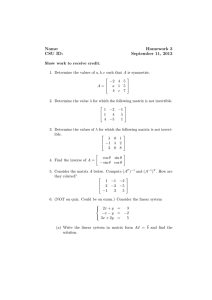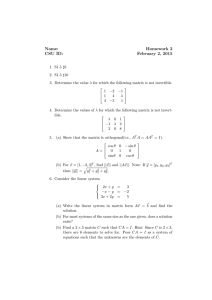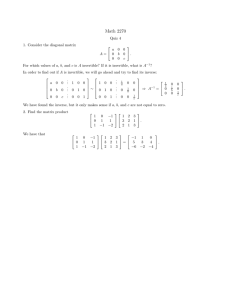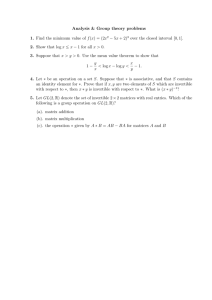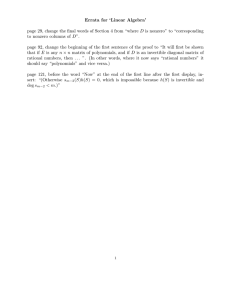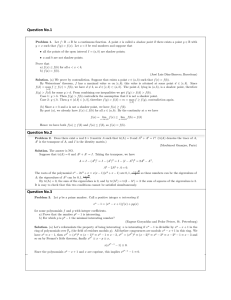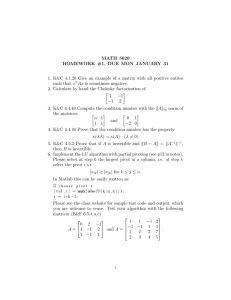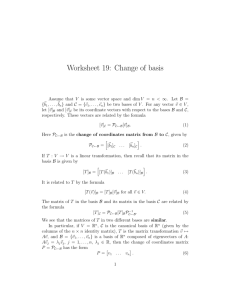Linear Algebra Problem Set: Systems, Matrices, Factorization
advertisement
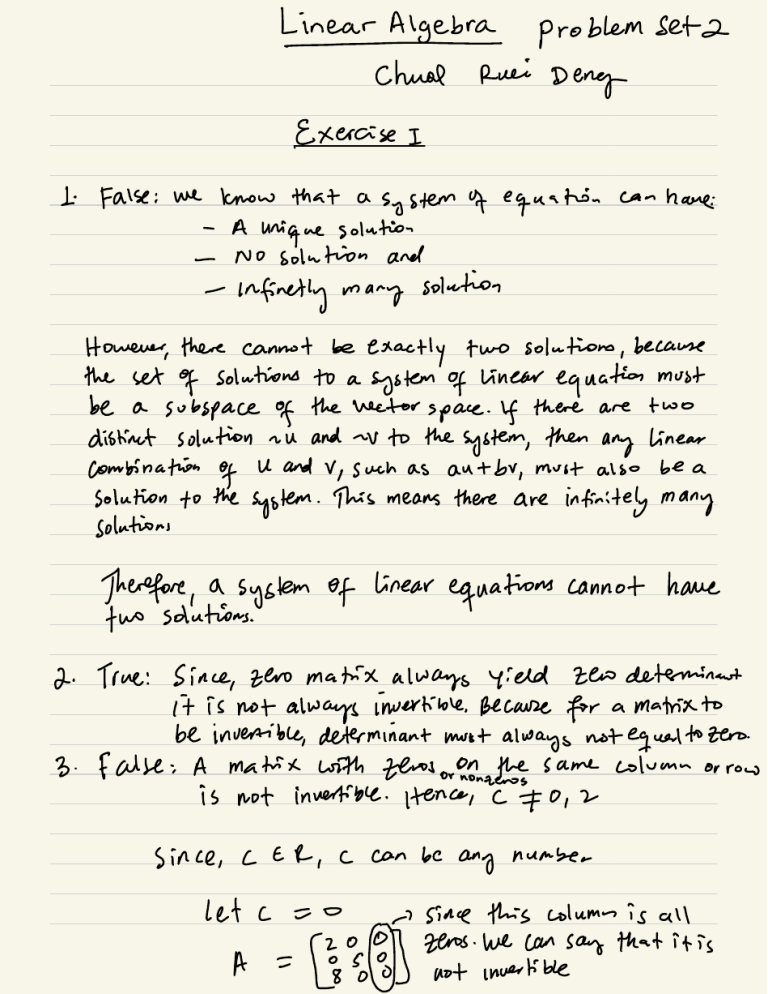
Algebra ear Dong Chuol Exercise 1 False:we know unique - However, there be solution No - Infinetly solutions subspace solution distinct of a combination solution to solutions Therefore, we to can have and a solution exactly two system of solution, because Linear equation the vector space. If there and it to the system, then must are two any linear be also ant by, U and V, such the system. This means there are infinitelymany of a system True:Since, a must as two solutions. 2. I system ofequation many be cannot set of Ruei solution A - the a that Set2 Problem linear equations of zero matix always have cannot yield zero determinant itis not always invertible. Because for a matrixto be invertible, determinant must always not equal to zero. - 3. with matrix False:A zeros onethe or is since, not C invertible. Hence, CR, c can be C any same column or F0,2 number thiscountoneit sine letc=oF invertible is row Here, every 4. False:Not diagonalis a must not be diagonal EX: is This invertible only entries True:We know only if determinantis diagonal the enties from definition that, A that not A. Now, same definition can exists A Ar (A) = a are none matrix matrix we is invertible = (AY2A (i3yB one zero A AAATAT AIA' Exercise A ofthe can is also invertible with inverse also show that : = diagonal none 2 and AA=A.A=I, Assuch that we a is invertible because itas is invertible if there also (c F0,2) door the Tmisisnotinvertiseas 5.0 of 5. if and 2 arezeros. [680] However, 0 and to matrices with diagonal invertible. is because are matrices equal = by the AA I = I = II (y-yi)c te = = 1. Solve the problem AF 3, = = (x, x2, 43) I where = (1, - [23- [x]= ↳ x1 into row 3x 4x3 1 + = + 2 2x1 5x 6x3 => + - Reduce this 2,4) - 2x1 - = + 742 - 9x3 4 = form echoleon L i j(] (*) 1 i - 7 = - 9 Lxc'js17cm :3 SJCR+, e R2 [OsclR]Rs,moS Ear Re + Therefore: x1 3x + x2 4x3 1 = + 2x3 4 = + x2 = 4 = - 4 = X 3 18 x2 = x( 1 - = 1 x= x1 3( 16) 48 + q = - - - 4(10) 40 9 = - = 240) 20 - 16 16 = Therefore, the solution Hence, we 2) We can have set (9, 16, 10) - = (x) (2) uniquesolution a = inverse ofA multiplicative find the using the identity of343 a (x1, Xu, (3) is matrix (i3x) = = 70 = !33s0O+RcanNOR ↑ [03/I ↓ 2P2 23 + - > R3 ~ Fo'12I -8) :32 1 100m car an (888(3, 72] I - - z re I ooolic) = - I A 1 (iii) = A · Now, we is correct A.A= check if can I to - A our that confirm answer [Ec] i ) 5 = 3 1 - 18 16 1 + 3 + 2 - - = 0 4 6 +4 - 30 24 0 0 = = + 2 +5 = Hence:AA 3. 6 = 4 - 10 - 1 6 = second can be if = the product - the of by verying that is first matrix equal the to 6 2 42 + - - 36 7 a + 4 14 + - 0 = 0 = 9 1 = matrices the or not exist number of number rows of columns the of If this condition is satisfied, then the matrices multiplied and the product exist. matrix. 3x3 i) - 6 0 + we need to check the - I To determine of = = BC 2xx2 2x3 -> We can columns 2x2 see B of the number of that and C are different Therefore, BC does the productofmatrix not exists ii) B 2458 (B = A since, the +3 number the that column ofB number the same, we are of CB product ofcard can row say exist. [ii[,,5i] 9 10i] - = = (iii) CB [9 103] - = 2x3 3x3 iii) ACB A and Since, the columns of 3x32x3 CB do We can have not say that rows of the same size (i.e3 #2) product:A'CB the does not exist. Exercise A III a a aare a = i) Find the upper triangular method. aosof = using elimination matrix Camaaat-nta ↑ ac 1 an obGasaaca 1 [ a & IaObaz.aBa-RInr a en aa ob-ab-ab 0bac - a - R3 R2 + a a I a - b-ac-ad-a 0 R3 + R2 P4 + 1·aa a 1 !·9.acacasade O b. ab.ab - a re a iv = O - aaa 0b.ab ab.a - 00 2 - bc - j b 00C -bd -5 2) This a [oaaasasaI is the upper matrix - re -> R4 23 R4 Ry + + triangular ii) find To factorization, A's LU ! a o u. = O - we know that scai c osni n . " ee Y a ① 0 all L i. L = we can 1 that determine a a a re I a = LV = a I ↓ Pu -> ↓ a a a b b b bcc triangular:Lower Theyare accaand 0 a - C :A LU = triangula:Upper is Diagonal:All enteries are upper - L the u lower - = L abcd 1 A ↑2000 A by-1 and we take :. Now, rows is zeros zero except the zeros ① diagonal Exercise. Find factorization 11 2 4 -I - 1 A - - - - I 2 126 4 - 4 Ry q 1 80 1 5R3 14 84 + - j - u 1 . = + + - 0 2 - - 3 Ri R4 + 4 - 0 L O 0 I - I 0 D O 2 L I o O I 4 - 4 2 - - 4 o -> D O 2 00 -10 R4 + - 4 I ↓ !! 1 3 -> 2 3 2 4 - I O - DU - - -31 o - 2 = D many e o 20 R2 2R1 Rc 7 I L A 1 ·- o 1.3 1 & 1 2 20 I - where q 1 2.1 is 1 I I LDU the 1 = ↓ oo o ⑧ 0 7 43 - -> ↓ - 5 We take the of rows 0 I 1/ opposite multiples. 1 0 I D 00 0 0 0 O 2 O o O = - D 20 3 1 .6 I u - 2 - o D 20 Now, 4 as 1 show the itis with zeros diagonal ↓ that A = from each their diagonal of upper parts. divide We u diagonal take and lower osI 00 we can We I/ ils = I of rows and U to 1. by change the LDU 1 ils [2- z-p 2,200000 = I - 4 A DV = 0 3 0 - D O 2 o O LDU - I - 2 d 4 :A 4 LDU = - 3 0 Yz I/ 0 Yz [0:"if I = /280l0-..of 7 - D - = 2 0 120. ils +;1, o O - 2 L I I 0 d 7 q O - 2 - 2 = 31 2 e) 1 -- 6 A 4 Exercise 1. 1 Factor * flf system the into A use PAL and We need to avoid any division 2x1 - by - - the LU rows or PA=LU exchange to zero x 2Xz 1 = + 6x1 +0xi 8x1 do = x2 - 2xz 0 = 5x3 4 = + [ ]3](x]] ] 7 en i z] :07 I = 5/ O A p Now, pA y = we can one = y n z - PA Gaussian elimination + - R2 Rj + u -132)3m 10 imo R5127 4R1 + R2 R2 182-23)m to find R3 1R3 re + ener (0 j, 3]. noTaking u .z = te multiples ofrows = exchanging sign their Now, We we can obtain (5 3 = they =b (i solve and then us = value [4007 for me = i.y) 14y yz + = yz = - 0 - = 4 - 3y1 3(1) - 3 - yz y3 4 = + ( 4) y3 4 - - 4 + 13 + = + 4 = 43 3 = i.[zy)=fy) ux y = when 5 [0j, 3(x)=te 2xy X272 1 x - 8x3 3 = 43 = 24. 1 (x1 ( z3) x(71 3x2 124 23 1 + 1 = + 24 48x1 23 18 = + + 48x1 48x1 41 + 24 = 24 - = 48x1 = x - 4/ 17 = - 3(8) = = + - - 342 = 342 3 x - = 4 + - 4 1 32 + 9 - - = 32 +9 - - 23 = 3 13 24 - = xz = = 2 - E 48 :(Ey)=8s -1 1 23 &

